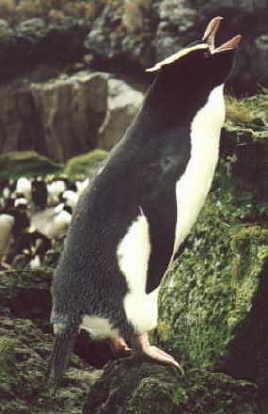


|
|
| |||



| ||||
. Erect-crested Penguin
Photos and map courtesy of |
|
Erect-crested PenguinEudyptes sclateriBreeding Range: Antipodes, Bounty, Auckland and Campbell Islands Length: 67cm. Weight: 4kg. World Population: 170,000 breeding pairs One of six species of crested penguin, the Erect-crested is only found in the New Zealand subantarctic region. The majority of the population is on the Antipodes and Bounty Islands, with smaller numbers on the Auckland and Campbell groups. Juveniles straggle to the New Zealand mainland, often to moult. One of the largest of the crested penguins, the erect-crested penguin stands approximately 50cm tall and weighs up to 4kg. The parallel brush-like crests identify this species, however it is easily confused with the Fiordland and Snares crested penguins, particularly at sea. Inhabitants of the sub-antarctic oceans, erect-crested penguins breed in large colonies on rocky coasts, often climbing very steep faces to breed on rock platforms. Erect-crested penguins often breed alongside rockhopper penguins. The males return to their breeding colonies in September, the females following two weeks later. Competition for nest sites can be fierce and fighting is common. A very simple nest is made, often comprising of just a few stones and a little mud. Two eggs are laid, the first of which is usually lost. The second egg is up to 100% larger than the first, and is the only one seriously incubated. The chicks fledge in February and the adults return to sea for the winter after moulting in March. Little is known about the erect-crested's diet, but it is thought that they are pelagic feeders, dining on fish and krill near the surface. They may travel hundreds of kilometers in search of food. The population of erect-crested penguins may be decreasing, but the extent of this decline, and the reasons for it, are not understood. Most of their breeding habitats are free of introduced predators, so this does not appear to be a significant factor. Unfortunately, the only way to view erect-crested penguins is to make a trip to a sub-antarctic island. A number of cruise ships visit the sub-antarctic region every year, many calling at New Zealand on their way. A few erect-crested penguins, probably juveniles, moult on the Otago coast late in the summer. Information taken from the New Zealand Penguins web site, where you can find further information. |